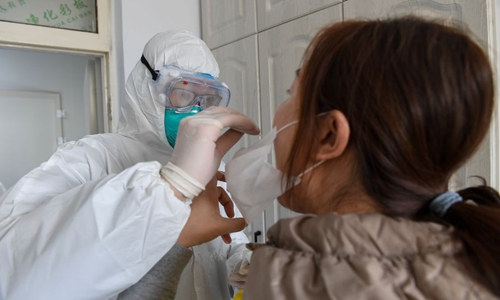HOME >> CHINA
Counting silent carriers eases fears
Source:Global Times Published: 2020/4/1 15:12:14
Imported symptom-free cases pose transmission risk

A staff member of Disease Control and Prevention Center of Saihan District takes sample from a resident for test in Hohhot, capital of north China's Inner Mongolia Autonomous Region, Feb.11, 2020. (Xinhua/Peng Yuan)
The Chinese mainland reported 130 new cases of people with no symptoms but tested positive for coronavirus on Tuesday, with two of them starting to show symptoms later on and confirmed of the virus infection, the Chinese National Health Commission (NHC) said on Wednesday, the first day the country started to update information on the number of asymptomatic carriers on a daily basis.
Chinese experts suggested strict quarantine and management policies on symptom-free coronavirus carriers, including those among imported cases, to prevent virus spread while highlighting this group's potential in promoting drugs and vaccines for the COVID-19 pandemic. They also tried to ease public concerns over them as they show limited infectivity.
A total of 1,367 asymptomatic-infected patients were still under medical observation, dropping by 174 from the previous day, the NHC said.
Releasing information on asymptomatic carriers is a government response to public concern, Yang Zhanqiu, a Wuhan-based virologist, told the Global Times on Wednesday.
Through the move, the authorities also want to remind the public and local governments to stay alert along with nationwide production resumption, as the epidemic situation is picking up in China, analysts noted.
Forty-seven among the 130 cases reported Tuesday are from Hubei. There are also 982 symptom-free cases currently under observation in the province, the local health authority said.
At a meeting on Monday, Ying Yong, Party chief of Hubei Province, stressed the importance of preventing and treating asymptomatic carriers as well as recovered patients infected again.
Once recovered, asymptomatic carriers and their close contacts should be quarantined and placed under observation immediately to curb the spread of the coronavirus. Recovered patients who get infected again will also be sent to the hospital for treatment, Ying noted.
Chinese top epidemiologist Zhong Nanshan Wednesday told media that asymptomatic cases would not cause a second outbreak in China as the country has built a powerful screening system. These cases and their close contacts would be quarantined once discovered and this move can cut virus spread timely.
While many local asymptomatic carriers in China may have already recovered as the epidemic situation in the country has eased, Zhang Wenhong, director of the Department of Infectious Diseases from Shanghai's Huashan Hospital, warned of imported cases who may have been infected recently and are more infectious than cases in China.
Zhang said in an article published by Caxin on Tuesday that 13 - 18 percent of infected patients in China are symptom-free virus carriers and the symptom-free virus carriers among imported cases, if not discovered, pose a higher risk of community transmission than local asymptomatic cases.
Northeast China's Heilongjiang Province said that they had discovered 19 asymptomatic carriers as of Tuesday, with 17 of them imported cases. The mainland has reported 691 imported cases, NHC said Wednesday.
China has reported 691 imported cases, NHC said Wednesday.
Asymptomatic carriers are not counted as confirmed cases in China as they do not show clinical manifestations, but have to undergo a 14-day quarantine for observation, according to China's seventh national therapy plan for COVID-19.
A Beijing-based expert on immunology urged research on these people to find out why they don't display symptoms. He asked if it is due to their own strong immunity system or the low activity of the virus they were exposed to. This could help accelerate the development of drugs and vaccine against the virus.
In an interview with the Global Times on Wednesday, the expert suggested isolating the virus in asymptomatic carriers' bodies to check if there are inactivated virus that can be used to develop inactivated vaccines for COVID-19.
As the coronavirus' activity declines with rising temperatures, the rate of asymptomatic cases may increase among the infected population in China, he said, calling for enhanced management on the group, especially in areas heavily stricken by the coronavirus to ensure the smooth resumption of operations nationwide.
Experts reached by the Global Times echoed the anonymous immunological expert's call, but they also tried to assure the public, saying this group shows lower infectivity than confirmed patients.
A confirmed COVID-19 patient can infect three people, Wang Guangfa, a leading Chinese respiratory expert at Peking University First Hospital in Beijing, told the Global Times on Tuesday, noting that propagation coefficients of an asymptomatic carrier would be lower than three.
Asymptomatic virus carriers have become a major public concern with the reopening of Hubei on March 25, which was the hardest-hit by COVID-19 in China and shut down for nearly two months. Several such cases have been reported across China, causing many places to require a second round of health checks on those traveling from Hubei even if they have green QR health codes that allow them to move freely around the country.
Shenzhen, South China's Guangdong Province, reported an asymptomatic virus carrier on Tuesday. The new case is a returnee from Hubei, the local health authority said.
Northwest China's Gansu Province on Tuesday launched thorough provincial screening on people returning from Hubei with green codes, requiring two consecutive negative results from nucleic acid tests before letting them move freely around the province. The two tests have to be conducted with a seven-day interval.
The move came after a man surnamed Hu, who drove from Xianning, Hubei to Gansu a week ago with a green code, tested positive for coronavirus on Sunday during a health check after entering Gansu. Forty-nine people who had close contact with Hu have been tracked down.
Before the case in Gansu, another Hubei resident with a green code, a man surnamed Tang, was also discovered to be infected on March 26 in Huizhou, South China's Guangdong Province. Tang was identified as an asymptomatic carrier, the local health authority said.
Posted in: SOCIETY